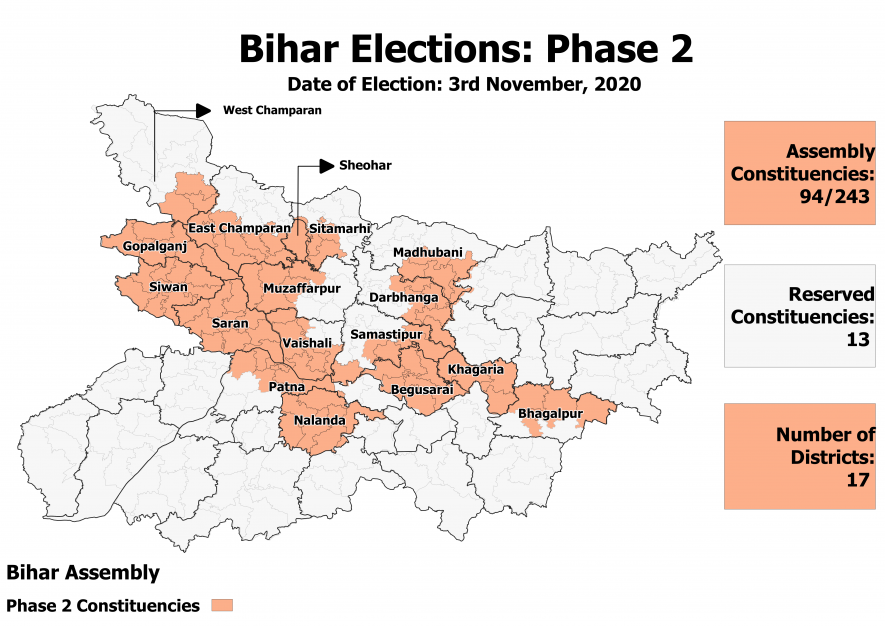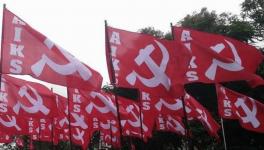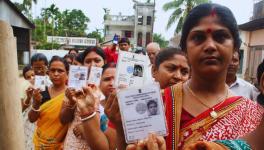Bihar Elections: In Crucial Phase 2, NDA Faces Trial by Fire
In what is turning out to be an unexpectedly close fight for the control of Bihar’s Assembly, the opposition Grand Alliance or Mahagathbandhan (MGB) takes on the ruling Janata Dal (United)-Bharatiya Janata Party alliance in 94 Assembly constituencies on November 3.
The belt going to polls in this phase 2 of the three-phase election lies in the plains in the north of river Ganga, except some parts of Patna and Begusarai districts, and the whole Nalanda district. Criss-crossed by rivers that flood vast tracts every year, the 17 districts that will see polling are witnessing a tough, no-holds-barred battle for Patna. The results in these seats may well determine the fate of the future government.

One of the distinctive features of this polling round is a higher degree of urban voters who have tended to support BJP in the past elections. This phase has 17 urban seats and 20 semi-urban seats, while the remaining 57 are rural seats. The BJP is banking on its traditional edge in urban areas, though it will be put to test in this election because of its participation in the unpopular Nitish Kumar government.
BJP’s Attempt at Communal Polarisation
In the 2015 Assembly elections, when JD(U) was aligned with the current opposition and BJP was fighting a lonely election on its own, these 94 seats had spectacularly favoured the then Grand Alliance. With 33 seats going to Rashtriya Janata Dal (RJD), 30 to JD(U) and seven to Congress, the alliance had swept up 70 of the 94 seats.
The BJP could manage only 20 seats while its ally, the Lok Janashakti Party (LJP) won only two seats. Going against this clear verdict, Nitish Kumar led his party out of the pre-election alliance and tied up with BJP in 2017, continuing as chief minister.
The BJP has used these three years to propagate its communal hatred, especially in some of the districts going to polls now, centred around various towns. In March 2018, Sangh Parivar affiliates like Vishwa Hindu Parishad and Bajrang Dal had been involved in taking out processions on Ramnavami, reportedly with armed youth indulging in provocative slogans. This led to clashes in districts which are going to polls on November 3: Bhagalpur, Samastipur, Nalanda and Siwan among others.
But, as with the rest of the state, BJP is itself facing a severe backlash because of the widespread anger against the misrule of the Nitish Kumar government. Raging unemployment, farmers’ distress, deindustrialisation, mishandling of the pandemic and a crumbling health and education infrastructure has sparked this anger which was visible in the first phase of polling on October 28, with support tilting toward a resurgent MGB.
Complex Electoral Calculus
Based on its self-perception of increased support and the more reasonable conclusion that Nitish Kumar and his JD(U) are unpopular, BJP has decided to contest 46 of the seats going to polls, leaving JD(U) only 43 seats and their smaller ally, Vikassheel Insaan Party or VIP, five seats in this phase. It has also covertly propped up its ally, LJP, (till recently led by the late Ram Vilas Paswan) which is contesting on 52 of the 94 second phase seats.
Interestingly, LJP is contesting against 42 of the 43 JD(U) candidates and all five VIP candidates. This may lead to some vote erosion of the JD(U) causing it to lose more seats. BJP had possibly thought that in a winning sweep, this would strengthen its own position vis-a-vis its ally JD(U). But, in such a close election as it is turning out to be, this seems to have backfired because it may lead to the ruling alliance’s total tally falling short of the halfway mark.
On the other side, the MGB is seeing an enthusiastic revival driven by huge public support for its platform of providing 10 lakh government jobs and other popular demands. Among the second phase seats, RJD is contesting on 56, Congress on 24 and the Left bloc on 14 seats. Reports suggest that there is energy in the united campaign with very insignificant in- fighting or divergence. Cadres of all MGB parties are seen working enthusiastically for whichever candidate is there in their respective areas.
Of the 14 seats in this phase that the Left is contesting as part of the MGB, the Communist Party of India (Marxist Leninist- Liberation) has fielded candidates in six seats and CPI(M) and CPI in four each. These are seats with strong Left roots and organisation, with support largely among the economically and socially most oppressed sections. This support base will get vastly supplemented by the support that RJD or Congress have among other landed sections and the middle class, if the political alliance works on the ground.
Overall, this phase of voting will most likely put a big dent in the JD(U)-BJP-VIP alliance and could potentially deal a debilitating blow to their electoral prospects.
Get the latest reports & analysis with people's perspective on Protests, movements & deep analytical videos, discussions of the current affairs in your Telegram app. Subscribe to NewsClick's Telegram channel & get Real-Time updates on stories, as they get published on our website.
























